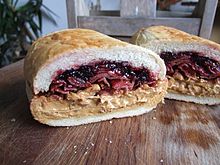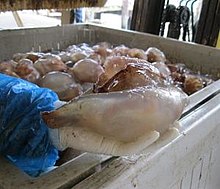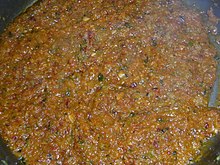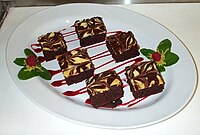F o o d
A portal dedicated to food and foodways
Introduction


Food is any substance consumed by an organism for nutritional support. Food is usually of plant, animal, or fungal origin and contains essential nutrients such as carbohydrates, fats, proteins, vitamins, or minerals. The substance is ingested by an organism and assimilated by the organism's cells to provide energy, maintain life, or stimulate growth. Different species of animals have different feeding behaviours that satisfy the needs of their metabolisms and have evolved to fill a specific ecological niche within specific geographical contexts.
Omnivorous humans are highly adaptable and have adapted to obtain food in many different ecosystems. Humans generally use cooking to prepare food for consumption. The majority of the food energy required is supplied by the industrial food industry, which produces food through intensive agriculture and distributes it through complex food processing and food distribution systems. This system of conventional agriculture relies heavily on fossil fuels, which means that the food and agricultural systems are one of the major contributors to climate change, accounting for as much as 37% of total greenhouse gas emissions. (Full article...)
Cooking, also known as cookery or professionally as the culinary arts, is the art, science and craft of using heat to make food more palatable, digestible, nutritious, or safe. Cooking techniques and ingredients vary widely, from grilling food over an open fire, to using electric stoves, to baking in various types of ovens, reflecting local conditions. Cooking is an aspect of all human societies and a cultural universal.
Preparing food with heat or fire is an activity unique to humans. Archeological evidence of cooking fires from at least 300,000 years ago exists, but some estimate that humans started cooking up to 2 million years ago.
The expansion of agriculture, commerce, trade, and transportation between civilizations in different regions offered cooks many new ingredients. New inventions and technologies, such as the invention of pottery for holding and boiling of water, expanded cooking techniques. Some modern cooks apply advanced scientific techniques to food preparation to further enhance the flavor of the dish served. (Full article...)

Fool's Gold Loaf is a sandwich made by the Colorado Mine Company, a restaurant in Denver, Colorado. It consists of a single warmed, hollowed-out loaf of bread filled with the contents of one jar of creamy peanut butter, one jar of grape jelly, and one pound (454 g) of bacon.
The sandwich's connection to the singer Elvis Presley is the source of its legend and prolonged interest. According to The Life and Cuisine of Elvis Presley, Presley and his friends took his private jet from Graceland, purchased 22 of the sandwiches, and spent two hours eating them and drinking Perrier and champagne before flying home. The story became legend and the sandwich became the subject of continued media interest and part of numerous cookbooks, typically focused on Presley's love of food. (Full article...)
Selected article –

Selected cuisine -
Taiwanese cuisine (臺灣料理; Táiwān liàolǐ; Tâi-oân liāu-lí, Bopomofo: ㄊㄞˊㄨㄢˉㄌㄧㄠˋㄌㄧˇ, or Chinese: 臺灣菜; pinyin: Táiwāncài; Pe̍h-ōe-jī: Tâi-oân-chhài, Bopomofo: ㄊㄞˊㄨㄢˉㄘㄞˋ) is a popular style of food with several variations, including Chinese and that of Taiwanese indigenous peoples, with the earliest cuisines known of being the indigenous ones. With over a hundred years of historical development, mainstream Taiwanese cuisine has been influenced by Hakka cuisine, the cuisines of the waishengren (people of other provinces), Japanese cuisine, and American cuisine, with southern Fujian cuisine having had the most profound impact.
Taiwan's cuisine is tied to its history of colonization and modern politics makes the description of Taiwanese cuisine difficult. As Taiwan developed economically fine dining became increasingly popular. Taiwanese cuisine has significant regional variations. (Full article...)Selected ingredient –
Sofrito (Spanish, Spanish: [soˈfɾito]), sofregit (Catalan, Catalan: [sufɾə'ʒit]), soffritto (Italian, Italian: [sofˈfritto]), or refogado (Portuguese, Portuguese: [ʁɨfuˈɣaðu]), is a basic preparation in Mediterranean, Latin American, Spanish, Italian and Portuguese cooking. It typically consists of aromatic ingredients cut into small pieces and sautéed or braised in cooking oil for a long period of time over a low heat.
In modern Spanish cuisine, sofrito consists of garlic, onion and peppers cooked in olive oil, and optionally tomatoes or carrots. This is known as refogado, sufrito, or sometimes as estrugido in Portuguese-speaking nations, where only garlic, onions, and olive oil are considered essential, tomato and bay laurel leaves being the other most common ingredients. (Full article...)
Selected recipe –
Brownies are typically eaten by hand or with utensils, and may be accompanied by a glass of milk, served warm with ice cream (à la mode), topped with whipped cream, or sprinkled with powdered sugar. In North America, they are common homemade treats and they are also popular in restaurants, ice cream parlors, and coffeehouses. (Full article...)
Pictured are Oatmeal Stout Brownies. This recipe, created by Joe Stutler, was a national finalist in the 2006 Cooking With Beer Challenge. The malt and oats in the beer enhance the flavor of the chocolate in these delicious brownies. Not overly cake-ey, not overly fudge-ey, the texture is nicely balanced. They're also decadently chocolate, and surprisingly light (thanks to the eggs). Great with a fruity beer, such as a lambic (Framboise, yum!).
Vegetable oils are triglycerides extracted from plants. Some of these oils have been part of human culture for millennia. Edible vegetable oils are used in food, both in cooking and as supplements. Many oils, edible and otherwise, are burned as fuel, such as in oil lamps and as a substitute for petroleum-based fuels. Some of the many other uses include wood finishing, oil painting, and skin care.
These oils make up a significant fraction of worldwide edible oil production. All are also used as fuel oils. (Full article...)Selected image –
Selected biography –
B. February 11, 1926 – d. January 20, 2018
Paul François Pierre Bocuse (French pronunciation: [pɔl bɔkyz]; 11 February 1926 – 20 January 2018) was a French chef based in Lyon known for the high quality of his restaurants and his innovative approaches to cuisine. Dubbed "the pope of gastronomy", he was affectionately nicknamed Monsieur Paul (Mister Paul). The Bocuse d'Or, a biennial world chef championship, bears his name.
A student of Eugénie Brazier, he was one of the most prominent chefs associated with the nouvelle cuisine, which is less opulent and calorific than the traditional cuisine classique, as well as stresses the importance of fresh ingredients of the highest quality. Bocuse claimed that Henri Gault first used the term, nouvelle cuisine, to describe food prepared by Bocuse and other top chefs for the maiden flight of the Concorde airliner in 1969. (Full article...)
Did you know (auto-generated) –

- ... that Miles Hadfield ensured supplies of food to Coventry during the Second World War Blitz?
- ... that certain Coccinellidae species lay extra infertile trophic eggs along with their fertile eggs so that their larvae can have a backup food source?
- ... that environmental activist Nigel Savage created Hazon after googling "Jewish food movement" and receiving zero search results?
- ... that Turkish migrant workers living in a residential complex in Amsterdam refused to eat the Dutch food for two weeks after the kitchen's only Turkish chef was fired?
- ... that Cranksgiving has been described as "part bike ride, part food drive, part scavenger hunt"?
- ... that after George Alexander Albrecht collapsed when conducting Beethoven's Ninth Symphony during a New Year's concert, he returned to composing and began hospice work?
More did you know –
Related portals
Food topics
The following are topics relating to food
Categories
Food list articles
- See also: Lists of foods and Category:Lists of drinks
The following are some Food list articles on Wikipedia:

- American cheeses
- Appellation d'Origine Contrôlée cheeses
- Apple cultivars
- Bacon dishes
- Bacon substitutes
- Basil cultivars
- Breads
- Breakfast beverages
- Breakfast cereals
- Breakfast foods
- British cheeses
- Cakes
- Candies
- Cheeses
- Cheese soups
- Christmas dishes (list)
- Cocktails
- Cookies
- Dishes using coconut milk
- Diets
- Doughnut varieties
- Egg dishes
- Fermented soy products
- Food additives
- Food additives (Codex Alimentarius)
- Foods named after people
- French cheeses
- French dishes
- Fried dough foods
- Fruits
- List of hamburgers
- Herbs and spices
- Hors d'oeuvre
- Indian dishes
- Indian snack foods
- Indonesian dishes
- Italian dishes
- Japanese snacks
- Japanese dishes
- Jewish dishes
- Kebabs
- Korean beverages
- Mango cultivars
- Moroccan dishes
- Pasta
- Pastries
- Philippine snack food
- Pies, tarts and flans
- Poppy seed pastries and dishes
- Potato dishes
- Puddings
- Raw fish dishes
- Rice dishes
- Rolled foods
- Sauces
- Seafood
- Seeds
- Sandwiches
- Snack foods
- Soft drinks by country
- Soul foods and dishes
- Soups
- Stews
- Street foods
- Tapas
- Turkish dishes
- Twice-baked foods
- Vegetable oils
- Vegetables
- Vodkas
Things you can do
Related WikiProjects
| Parent project: WikiProject Food and Drink | |
| Child projects: | Task forces: (All inactive) |
|
|
| Related projects: | |
New articles
Rules | Match log | Results page (for watching) | Last updated: 2024-06-02 19:26 (UTC)
Note: The list display can now be customized by each user. See List display personalization for details.
- Red Boat (edit | talk | history | links | watch | logs | tools) by Valereee (talk · contribs · new pages (7)) started on 2024-06-02, score: 10
- Agrosuper (edit | talk | history | links | watch | logs | tools) by FrederickEvans (talk · contribs · new pages (22)) started on 2024-06-02, score: 30
- Fowler Ltd. (edit | talk | history | links | watch | logs | tools) by EssNS (talk · contribs · new pages (31)) started on 2024-06-01, score: 10
- Nilla Wafers (edit | talk | history | links | watch | logs | tools) by Voorts (talk · contribs · new pages (48)) started on 2024-05-26, score: 10
- Solari's (edit | talk | history | links | watch | logs | tools) by Nolabob (talk · contribs · new pages (1)) started on 2024-06-01, score: 20
- Nasi katok (edit | talk | history | links | watch | logs | tools) by The Bangsawan (talk · contribs · new pages (11)) started on 2024-06-01, score: 20
- Justin Sterner (edit | talk | history | links | watch | logs | tools) by Muboshgu (talk · contribs · new pages (15)) started on 2024-05-31, score: 10
- Warankasi (edit | talk | history | links | watch | logs | tools) by Wiisstlo (talk · contribs · new pages (5)) started on 2024-05-26, score: 20
- Brennans Bread (edit | talk | history | links | watch | logs | tools) by Gatepainter (talk · contribs · new pages (3)) started on 2024-05-31, score: 20
- Karin-Lis Svarre (edit | talk | history | links | watch | logs | tools) by Ipigott (talk · contribs · new pages (11)) started on 2024-05-31, score: 10
- Indori poha (edit | talk | history | links | watch | logs | tools) by Apocheir (talk · contribs · new pages (5)) started on 2024-05-30, score: 20
- Tanuki (restaurant) (edit | talk | history | links | watch | logs | tools) by Another Believer (talk · contribs · new pages (108)) started on 2024-05-30, score: 10
- Lena Ice Cream (edit | talk | history | links | watch | logs | tools) by Syazwi Irfan (talk · contribs · new pages (3)) started on 2024-05-23, score: 30
- Ko Myeong-seok (edit | talk | history | links | watch | logs | tools) by Explicit (talk · contribs · new pages (4)) started on 2024-05-30, score: 10
- Savanyúság (edit | talk | history | links | watch | logs | tools) by Konnor Martin (talk · contribs · new pages (1)) started on 2024-05-29, score: 10
- Laal maas (edit | talk | history | links | watch | logs | tools) by SafariScribe (talk · contribs · new pages (119)) started on 2024-05-29, score: 30
- Furrundu (edit | talk | history | links | watch | logs | tools) by BaduFerreira (talk · contribs · new pages (3)) started on 2024-05-29, score: 50
- Hyman's Seafood (edit | talk | history | links | watch | logs | tools) by DMVHistorian (talk · contribs · new pages (6)) started on 2024-05-28, score: 10
- Pickup Coffee (edit | talk | history | links | watch | logs | tools) by Hariboneagle927 (talk · contribs · new pages (22)) started on 2024-05-28, score: 20
- Geoffrey Hawtin (edit | talk | history | links | watch | logs | tools) by Chromista (talk · contribs · new pages (1)) started on 2024-05-28, score: 10
- Palani Panchamirtham (edit | talk | history | links | watch | logs | tools) by Magentic Manifestations (talk · contribs · new pages (14)) started on 2024-05-27, score: 10
- Erismatopterus (edit | talk | history | links | watch | logs | tools) by Kevmin (talk · contribs · new pages (20)) started on 2024-05-27, score: 10
- Saskatoon berry pie (edit | talk | history | links | watch | logs | tools) by Reywas92 (talk · contribs · new pages (2)) started on 2024-05-27, score: 30
- Zus Coffee (edit | talk | history | links | watch | logs | tools) by Hariboneagle927 (talk · contribs · new pages (22)) started on 2024-05-27, score: 20
- Space Cola Wars (edit | talk | history | links | watch | logs | tools) by Artem.G (talk · contribs · new pages (13)) started on 2024-05-27, score: 10
- Conchas de Piedra (edit | talk | history | links | watch | logs | tools) by Another Believer (talk · contribs · new pages (108)) started on 2024-05-27, score: 10
- Torta Balcarce (edit | talk | history | links | watch | logs | tools) by Murmuring Rock (talk · contribs · new pages (4)) started on 2024-05-25, score: 20
- Bilal Yalcinkaya (edit | talk | history | links | watch | logs | tools) by Das osmnezz (talk · contribs · new pages (42)) started on 2024-05-23, score: 10
- Andok's (edit | talk | history | links | watch | logs | tools) by Karich28 (talk · contribs · new pages (4)) started on 2024-05-22, score: 20
- Doe Donuts (edit | talk | history | links | watch | logs | tools) by Another Believer (talk · contribs · new pages (108)) started on 2024-05-23, score: 10
- I, the Executioner (2024 film) (edit | talk | history | links | watch | logs | tools) by Οἶδα (talk · contribs · new pages (60)) started on 2024-05-21, score: 10
- Virginia Sole-Smith (edit | talk | history | links | watch | logs | tools) by Marquardtika (talk · contribs · new pages (1)) started on 2024-05-22, score: 10
- Lohusa şerbeti (edit | talk | history | links | watch | logs | tools) by Macrakis (talk · contribs · new pages (8)) started on 2024-05-22, score: 30
- I, the Executioner (edit | talk | history | links | watch | logs | tools) by Οἶδα (talk · contribs · new pages (60)) started on 2024-05-21, score: 10
- Paul Parkman (edit | talk | history | links | watch | logs | tools) by Thriley (talk · contribs · new pages (69)) started on 2024-05-21, score: 10
- Two Roosters Ice Cream (edit | talk | history | links | watch | logs | tools) by Johnson524 (talk · contribs · new pages (3)) started on 2024-05-21, score: 10
- There Be Monsters (edit | talk | history | links | watch | logs | tools) by Another Believer (talk · contribs · new pages (108)) started on 2024-05-21, score: 10
- Chinir saaj (edit | talk | history | links | watch | logs | tools) by Moriwen (talk · contribs · new pages (263)) started on 2024-05-21, score: 30
- Doogh (edit | talk | history | links | watch | logs | tools) by MuhammedBenShalom (talk · contribs · new pages (1)) started on 2024-05-21, score: 20
- Sata physic gardens (edit | talk | history | links | watch | logs | tools) by MChew (talk · contribs · new pages (22)) started on 2024-05-21, score: 10
- Nam Dae-sik (edit | talk | history | links | watch | logs | tools) by Das osmnezz (talk · contribs · new pages (42)) started on 2024-05-20, score: 10
- Le Chique (edit | talk | history | links | watch | logs | tools) by Another Believer (talk · contribs · new pages (108)) started on 2024-05-20, score: 10
- Pao Alentejano (edit | talk | history | links | watch | logs | tools) by Valereee (talk · contribs · new pages (7)) started on 2024-05-20, score: 10
- Sir Grapefellow and Baron von Redberry (edit | talk | history | links | watch | logs | tools) by Retrosunshine2006 (talk · contribs · new pages (1)) started on 2024-05-20, score: 20
- Pharasmanes II (edit | talk | history | links | watch | logs | tools) by BilledMammal (talk · contribs · new pages (186)) started on 2024-05-19, score: 10
- Kinamatisang manok (edit | talk | history | links | watch | logs | tools) by Obsidian Soul (talk · contribs · new pages (6)) started on 2024-05-19, score: 10
- Federal Food, Drug, and Cosmetic Act of 1938 (edit | talk | history | links | watch | logs | tools) by Irruptive Creditor (talk · contribs · new pages (2)) started on 2024-05-19, score: 10
- IT'SUGAR (edit | talk | history | links | watch | logs | tools) by AbsentPat (talk · contribs · new pages (5)) started on 2024-05-19, score: 20
- Harvey's Butter Rum Batter (edit | talk | history | links | watch | logs | tools) by AbsentPat (talk · contribs · new pages (5)) started on 2024-05-19, score: 20
- Khanom Med Khanoon (edit | talk | history | links | watch | logs | tools) by Quantplinus (talk · contribs · new pages (0)) started on 2024-05-18, score: 10
Associated Wikimedia
The following Wikimedia Foundation sister projects provide more on this subject:
-
Commons
Free media repository -
Wikibooks
Free textbooks and manuals -
Wikidata
Free knowledge base -
Wikinews
Free-content news -
Wikiquote
Collection of quotations -
Wikisource
Free-content library -
Wikiversity
Free learning tools -
Wiktionary
Dictionary and thesaurus














































